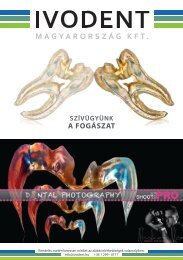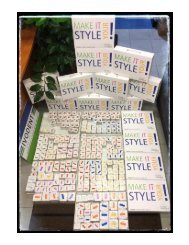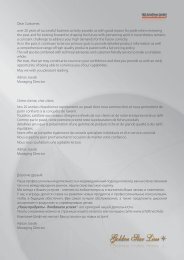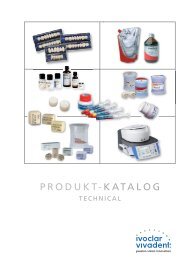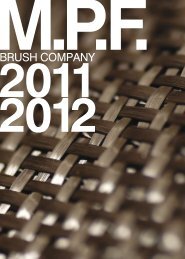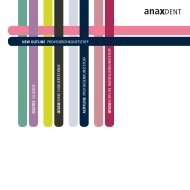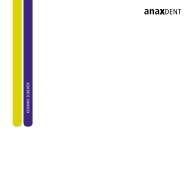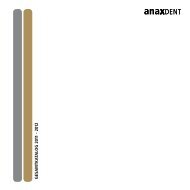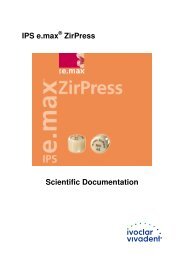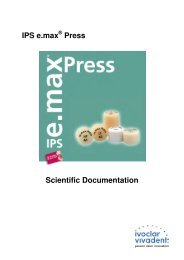MANUAL
Erfolgreiche ePaper selbst erstellen
Machen Sie aus Ihren PDF Publikationen ein blätterbares Flipbook mit unserer einzigartigen Google optimierten e-Paper Software.
y Christian Coachman<br />
<strong>MANUAL</strong>
anaxGUM ist ein zahnfleischfarbenes Komposit zur ästhetischen Wiederherstellung gingivaler Anteile. Es wird vom Zahntechniker im Labor<br />
sowie vom Zahnarzt direkt im Mund des Patienten verwendet. anaxGUM für den einfachen Weg zurück zu einem natürlichen Erscheinungsbild<br />
der Gingiva.<br />
anaxGUM is a tissue-colored composite to be used for the esthetic reconstruction of gingival parts. It can either be applied by the dental<br />
technician at the dental lab or directly in the patient‘s mouth by the dentist. anaxGUM – for the simple way back to a natural appearance of<br />
the gums.<br />
3
Das natürliche Erscheinungsbild des Zahnfleisches (rote Ästhetik) ist gleichbedeutend wie die Erstellung eines perfekten Zahnersatzes (weiße<br />
Ästhetik). anaxgum wurde entwickelt um die verschiedenen Nuancen der natürlichen Gingiva so exakt als möglich nachzubilden. anaxgum ist ein<br />
genau aufeinander abgestimmtes System von Pasten (Gingiva Paste) und flüssigen Modelliermaterialien (Paint/Flow). Seine mannigfaltigen Variationsmöglichkeiten<br />
eröffnen ein breites Spektrum zur individuellen Reproduktion der Gingiva des Patienten. Es ist anwendbar für implantatgetragene<br />
Suprakonstruktionen, Kronen und Brückentechnik, abnehmbaren Zahnersatz und zur Individualisierung in der Totalprothetik.<br />
Im Besonderen ist anaxgum für die direkte Anwendung im Mund geschaffen. Arbeiten von der Feinkorrektur bei Approximalraumverschlüssen bis hin<br />
zur gesamten Nachahmung der Gingivaplastik können direkt im Mund des Patienten vorgenommen werden. Die hohe Dichte des Komposits gewährleistet<br />
seine gute Polierbarkeit und stellt somit die langfristige Hygiene der Arbeit sicher.<br />
The natural appearance of the gums (red esthetics) should have the same importance than the creation of a perfect dental restoration (white esthetics).<br />
anaxgum was developed to match the different hues of the natural gingiva as accurately as possible. anaxgum is a well coordinated system of<br />
pastes (Gingiva Paste) and liquid modelling materials (Paint/Flow). Its manifold variation possibilities include a wide<br />
spectrum for the individual reproduction of the patient‘s gingiva. It can be used for screw retained implant substructures, in crown and bridge technique,<br />
for removable restorations as well as for the individualization of full dentures.<br />
anaxgum was especially designed for the direct use in the mouth. Restorations from the replacement of missing papillas and closing black triangles<br />
up to the complete imitation of a gingivoplasty can be realized directly in the patient‘s mouth. The high density of the composite guarantees its easy<br />
polishability and, thus, ensures long-term hygiene of the restoration.<br />
4
01 02<br />
03<br />
04 05<br />
06<br />
6<br />
Bild 01 Präoperative Situation mit gravierendem Knochenverlust am Frontzahn (21). Bild 02 Das diagnostische Wax-up veranschaulicht das fehlende<br />
Weichgewebe sowie die ideale Zahnform. Die besondere Herausforderung lag in den Platzverhältnissen, da der mesiodistale Abstand des linken mittleren<br />
Frontzahnes geringer war als der des rechten mittleren Frontzahnes. Dieses Problem wurde gelöst, indem die zukünftige Krone labial in Position des einstigen<br />
natürlichen Zahnes gebracht wurde. Bild 03 Um eine verschraubte Restauration zu ermöglichen, wurde das Implantat gleich nach der Extraktion<br />
palatinal positioniert. Diese Position ist obligatorisch für eine künstliche Gingiva-Restaurierung dieser Art. Eine vertikale Augmentation wurde nicht versucht.<br />
Bild 04 Individuelle zahnfleischfarbene Keramikplättchen wurden für die Farbauswahl der Gingiva gebrannt. Bild 05 Die polierte Metall-Keramik-<br />
Restauration nach dem Glanzbrand. Bild 06 1. Phase des zweistufigen Zahnfleischanpassungsprozesses: Bei der ersten Einprobe der fertig gebrannten<br />
Keramikkrone mit gingivalem Keramikanteil war das Zahnfleisch aufgrund der vorangegangenen Maßnahmen, z. B. Lokalanästhesie und Umgestaltung,<br />
in einem schlechten Zustand. Dadurch würde die Anpassung von Form, Farbe und Oberflächenstruktur stark beeinträchtigt werden. Dieses Problem<br />
wurde so gelöst, dass zuerst nur die Krone mit dem Keramikanteil eingesetzt und das rote Kompositmaterial in einer späteren Sitzung geschichtet wurde,<br />
als das Weichgewebe abgeheilt war. Bilder 07-12 2. Phase: Vorbereitungen vor dem Aufbringen von anaxgum: mechanische Retention, sandstrahlen,<br />
anätzen, dampfstrahlen, silanisieren, Adhäsiv auftragen.
07 08<br />
09<br />
10 11<br />
12<br />
Picture 01 Preoperative situation with extensive circumferential bone loss. Picture 02 The diagnostic wax-up shows the amount of soft tissue missing<br />
and the ideal tooth shape. It was quite challenging to deal with the space because of the mesiodistal distance which was smaller for the left central incisor<br />
than for the right central incisor. This problem was solved by planning the future crown in the buccal position as it was in the preoperative situation.<br />
Picture 03 Immediate implant placement, palatally positioned to realize a screw-retained restoration. This is mandatory for a prosthetic restoration of<br />
this type. A vertical augmentation was not attempted. Picture 04 Customized tissue-colored ceramic shade tabs were produced for the shade selection<br />
of the gingiva color. Picture 05 Metal-ceramic restoration after glaze bake and polishing. Picture 06 1 st phase of the two-stage gingiva adaptation<br />
technique: At the first insertion appointment, the patient‘s soft tissue is not in an ideal condition due to the previous treatment such as numbing and<br />
reshaping. This complicated the adaptation of the shape, color, and texture extremely. In this case, the best solution was to insert the restoration with<br />
the finished ceramic part and to add the pink composite resin in a second appointment after the soft tissue has healed. Pictures 07-12 2 nd phase: The<br />
restoration is prepared for the application of anaxgum: mechanical retention, sandblasting, acid etching, steam cleaning, silane, adhesive.<br />
7
13<br />
14<br />
15<br />
16<br />
Bild 13 Erste Schicht: anaxgum Paint. Bild 14 Lichthärten Bild 15 Die vorbereitete Restauration in situ, bereit für die direkte Schichtung anaxgum. Bild<br />
16 Die Grafik zeigt den Anteil der aufzutragenden zahnfleischfarbenen Keramik und den Platzbedarf für das rosafarbene Komposit (gelbe Linie). Bilder<br />
17-18 anaxgum in verschiedenen Farben und Translusenzen. Bild 19 Das Auftragen des Komposits erfolgt mit einem Spatel, beginnend mit der dunkleren<br />
Farbe als Hintergrund. Bild 20 Aufbringen einer helleren Kompositfarbe. Bild 21 Mit einem flachen Pinsel (anaxbrush No.2) den Übergang zum Rand hin<br />
dünn ausstreichen.<br />
86
17 18<br />
19 20<br />
21<br />
Picture 13 First layer: anaxgum Paint. Picture 14 Light polymerization Picture 15 The prepared restoration in situ - ready for direct build-up with anaxgum.<br />
Picture 16 Schematic illustration showing the amount of pink ceramic to be placed and the space to be used for the pink composite resin (yellow<br />
line). Pictures 17-18 anaxgum in different colors and translucencies. Picture 19 The composite resin is applied by means of a spatula, starting with a<br />
darker color as background. Picture 20 Adding a lighter color of the composite resin. Picture 21 The margins are blended with a flat brush (anaxbrush<br />
No.2).<br />
9
22<br />
23<br />
24<br />
25 26<br />
Bild 22 Mit einer feinen Sonde Vertiefungen und den Anschein eines natürlichen Sulkuses schaffen. Bild 23 Nach jeder Schicht lichthärten. Bilder 24 - 26<br />
Lichthärtende Malfarben (anaxgum Paint) werden zur Individualisierung der Farbe verwendet. Bild 27 Für die Gestaltung der Oberflächenstruktur wird<br />
ein Pinsel verwendet. Bild 28 Der fertige Zahnfleischaufbau. Bild 29 Die Restauration wird herausgeschraubt und ausserhalb des Mundes fertiggestellt.<br />
Aufgrund der approximalen Ausweitung der künstlichen Gingiva sollte das Einsetzen in zwei Richtungen erfolgen: erst horizontal, dann vertikal. Um<br />
dies zu ermöglichen, sollte das Implantat eine externe Verbindung oder eine sehr kurze interne Verbindung aufweisen. Bild 30 Die dünnen Ränder des<br />
zahnfleischfarbenen Komposits müssen beschliffen werden. Außerdem sollten die untersichgehenden Stellen entfernt werden um lange Haltbarkeit und<br />
gute Hygiene zu gewährleisten.<br />
10
27 28<br />
29<br />
30<br />
Picture 22 Creating grooves as well as the illusion of a gingival sulcus by means of a fine-tipped probe. Picture 23 Light-cure after each layer. Pictures<br />
24-26 Customizing the color with light-curing stains (anaxgum Paint). Picture 27 A brush is used to create the superficial texture. Picture 28 The finished<br />
composite resin build-up. Picture 29 The restoration is removed to finish the pink composite resin outside the mouth. Due to the interproximal extension<br />
of the artificial gingiva, the path of insertion should have two directions: first horizontal and then vertical. To accomplish this, the implant should have<br />
either an external connection or a very short internal connection. Picture 30 The thin edges of the tissue-colored composite are to be trimmed, and the<br />
undercuts should be removed to improve durability and hygiene.<br />
31<br />
11
31 32<br />
33<br />
34 35<br />
36<br />
12<br />
Bild 31 Optimaler Verlauf des pinkfarbenen Komposits nach der Schichtung im Mund. Bild 32 Nach dem Herausnehmen der Restauration wird ein sehr<br />
feiner Überschuss am Rand des künstlichen Zahnfleisches sichtbar, der entfernt werden muss. Bild 33 Entfernen der Kante mit einem Diamantschleifer im<br />
45°-Winkel. Bild 34 Randreduktion, aber nicht vollständig entfernt. Durch das Auftragen einer extra Schicht Komposit werden untersichgehende Stellen<br />
beseitigt. Diese Schicht übt einen zusätzlichen Druck auf das Weichgewebe aus und ergibt einen feinen Übergang. Bild 35 Die untersichgehende Stelle<br />
und die dünne Kante sind eliminiert. Bild 36 In dieser Phase ist das Ziel die Gestaltung des Übergangs von künstlichem zu natürlichem Weichgewebe.<br />
Da nach dem Entfernen des dünnen rosa Kompositrandes ein sichtbarer und unschöner Übergang vorhanden ist, muss dieser modifiziert werden. Bild<br />
37 Dieser sichtbare Übergang wird vor allem durch die unterschiedliche Lichtreflexion des künstlichen Anteils und der natürlichen Gingiva verursacht.<br />
Bild 38 Es ist notwendig einen Diamantschleifkörper mit abgerundeter Spitze zu benutzen, um den Verlauf der künstlichen Gingiva an die natürliche<br />
Gingiva anzupassen. Bild 39 Der unnatürliche Winkel zwischen den Profilen wird angeglichen. Bild 40 Das Endergebnis ist, dass die Reflexion des Lichts<br />
nun einen ähnlichen Abstrahlwinkel auf das natürliche und auf das künstliche Weichgewebe aufweist und somit einen Zusammenhang vortäuscht. Durch<br />
den Speichel wird dieser Effekt noch verbessert.
32 37<br />
33<br />
38<br />
39<br />
40<br />
Picture 31 Ideal design of the pink composite resin after the application in the mouth. Picture 32 After removing the restoration from the mouth, the<br />
thin extension on the edge of the pink composite resin must be trimmed. Picture 33 Removal of the edge with a diamond bur in an angle of 45 degrees.<br />
Picture 34 The edge is reduced but not removed completely. The undercut is eliminated by adding an additional layer of composite resin providing extra<br />
pressure on the soft tissue and smoothing the edge. Picture 35 The undercuts and thin edges are just gone. Picture 36 At this stage, the goal is to blend<br />
the transition between the artificial and the natural soft tissue. Since the removal of the pink composite resin edge creates a visible and unattractive<br />
interface, this must be modified. Picture 37 The visible interface occurs mainly because of the different light reflection of the artificial part and of the<br />
natural gingiva. Picture 38 A rounded diamond bur is used to adapt the profile of the artificial gingiva at the natural gingiva. Picture 39 The unnatural<br />
angle between the artificial and the natural gingiva is removed. Picture 40 The light reflection has now a similar direction on the natural and on the<br />
artificial soft tissue and, thus, provides the illusion of continuity. This mimetic effect improves even more in the salivating oral environment.<br />
13
41 42<br />
43<br />
44 45<br />
14<br />
Bild 41 Um die Hygienefähigkeit aufrecht zu erhalten, müssen untersichgehende Stellen und Konkavitäten mit zahnfleischfarbenem Komposit aufgefüllt<br />
werden. Zum Verbund wird bond LC an den zu korrigierenden Stellen appliziert. Bild 42 Abschließendes Emergenzprofil nach dem Beschleifen und Auftragen<br />
von Komposit im Behandlungsstuhl. Bild 43 Beim abschließenden Polieren mit Pasta Grigia II darf die zahnfleischähnliche Struktur nicht zerstört<br />
werden. Bilder 44 – 45 Hygienemaßnahmen: Es muss möglich sein, die Zahnseide auf beiden Seiten um das künstliche Zahnfleisch herumzuführen und<br />
somit den Übergang zwischen natürlicher und künstlicher Gingiva zu reinigen.
Picture 41 Undercuts and concavities must be filled with pink composite to ensure a good oral hygiene in this place. Increased bonding is achieved by<br />
applying bond LC on the according areas. Picture 42 Final emergence profile after reshaping and adding composite resin at chairside. Picture 43 During<br />
the final polishing with Pasta Grigia II, care must be taken not to remove the gingiva-like texture. Pictures 44-45 Hygiene procedures. It is necessary<br />
to guide the floss around the artificial gingiva on both sides and, thus, completely clean the interface between the natural and the artificial gingiva.<br />
15
LABOR<br />
LAB<br />
01 02<br />
03<br />
04 05<br />
06<br />
Bild 01 Auftragen von Opaquer anaxgum PO I und anaxblend. Bild 02 Dark pink flächig als Grundmasse auftragen. Interalveolär bis zur Umschlagfalte<br />
mit dark pink bis zur Endform ergänzen. Bild 03 Vorbereitung der Alveolenhügel mit anaxgum orange. Bild 04 Den Papillenrand mit light pink verfeinern<br />
und mit einem Pinsel Richtung appikal runterstreichen. Bild 05 Mit anaxblend flow Dentin A2 den Alveolenhügel aufbauen. Zur Angleichung des wärmeren<br />
Farbtons von Eckzähnen den Wurzelverlauf mit anaxblend flow B3 aufbauen. Bild 06 Fertiggestellter Alveolenhügel: Die approximale Verbindung<br />
des Kammes mit anaxblend flow Dentin A2 herstellen. Bild 07 Zur leichten Aufhellung der gingivalen Oberfläche wird anaxblend flow S 57 unterhalb des<br />
Sulkusverlaufes aufgetragen. Bild 08 Ausarbeitung zur Darstellung der Papillen und Stippelung. Bild 09 Handstückpolitur mit Pasta Grigia II und spitzer<br />
Polierbürste. Bild 10 Hochglanzpolieren mit Handstückschwabbel.<br />
18
07 08<br />
09<br />
10<br />
Picture 01 Application of the opaquer anaxgum PO I and anaxblend. Picture 02 Apply a sufficient amount of dark pink as basic material. Interalveolar<br />
supplementation with dark pink up to the reflections until the final shape is reached. Picture 03 Add anaxgum orange to prepare the alveolar tubercles.<br />
Picture 04 Refine the papilla margin with light pink and wipe it down towards the apex with a brush. Picture 05 Build the alveolar tubercle using anaxblend<br />
Flow Dentin A2. The warmer hue of canines can be matched by building up the course of the root with anaxblend Flow B3. Picture 06 The finished<br />
alveolar tubercle: Use anaxblend Flow Dentin A2 to create the interproximal connection of the ridge. Picture 07 Apply anaxblend Flow S 57 below the<br />
sulcus line to slightly brighten up the gingival surface. Picture 08 Finish to work out the papillae and the stippling. Picture 09 Polished by means of a<br />
handpiece with Pasta Grigia II and a pointed polishing brush. Picture 10 Buffing provides high gloss.<br />
19
anaxGUM Opaquer 3g<br />
PO I light<br />
PO II dark<br />
anaxGUM Gingiva Paste 4g<br />
light pink<br />
dark pink<br />
orange pink<br />
purple pink<br />
brown pink<br />
anaxschubladenschränkle<br />
anaxbox<br />
anaxGUM Gingiva Flow 3g<br />
light pink<br />
dark pink<br />
orange pink<br />
transluzent pink<br />
anaxGUM Paint 3g<br />
red<br />
purple<br />
cream<br />
dark brown<br />
yellow<br />
20
anaxGUM KIT S<br />
anaxGUM Gingiva Paste 4g<br />
light pink<br />
dark pink<br />
anaxGUM Paint 3g<br />
red<br />
purple<br />
Equipment<br />
application tips, 2 pcs.<br />
anaxGUM KIT XL<br />
anaxGUM Opaquer 3g<br />
PO I light<br />
PO II dark<br />
anaxGUM Gingiva Paste 4g<br />
light pink<br />
dark pink<br />
orange pink<br />
purple pink<br />
brown pink<br />
anaxGUM Paint 3g<br />
red<br />
purple<br />
cream<br />
dark brown<br />
Equipment<br />
application tips, 4 pcs.<br />
anaxrack<br />
anaxrack<br />
21
Equipment<br />
anaxbrush 00<br />
anaxbrush No 2<br />
cover gel<br />
pasta grigia II<br />
skin primer<br />
skin glaze<br />
bond LC<br />
metal bonder<br />
zirkon bonder<br />
anaxbox<br />
anaxrack<br />
warm up<br />
application tips, 20 pcs.<br />
warm up<br />
warm up<br />
Spritzenwärmer<br />
Anhand der variablen Temperaturregelung wird eine verbesserte<br />
Modellations- und Fließfähigkeit von Compositen erreicht.<br />
syringewarmer<br />
With the help of the temperature control you improve the ability of<br />
modellation and the ease of flow.<br />
22
GEBRAUCHSANLEITUNG<br />
INSTRUCTIONS FOR USE<br />
Anwendungsgebiete:<br />
• ästhetische Wiederherstellung von gingivalen Anteilen bei Zahnersatz mit starkem Knochenverlust<br />
• Verblendung des Gingivabereiches von herausnehmbaren Kombinationsarbeiten (Teleskop-/Konuskronen und Geschiebearbeiten)<br />
• Suprakonstruktion von Implantatarbeiten<br />
• Charakterisieren von Prothesen<br />
Verarbeitungszeit: 1-3 min. je nach Lichtverhältnissen<br />
Polymerisation: Für die Polymerisation ist ein Lichtpolymerisationsgerät mit einem Emissionsspektrum im Bereich von 350-500nm einzusetzen.<br />
Die geforderten physikalischen Eigenschaften werden nur mit ordnungsgemäß arbeitenden Lampen erzielt. Deshalb ist eine regelmäßige Überprüfung<br />
der Lichtintensität nach den Angaben des Herstellers erforderlich. Wenn die Aushärtung mit einer Polymerisationslampe vorgenommen wird, anaxgum<br />
von allen Seiten bestrahlen.<br />
Polymerisationszeiten je Schicht (max. 2 mm): Heraflash und UniXS: 3 min / Spectramat: 5 min / Spektra LED: 3 min / SolidiliteV: 5 min / GC Labo light<br />
LV-III: 5 min / Handlampe: 40 sek<br />
Fields of application:<br />
• esthetic rehabilitation of gingival parts in case of dental restorations with severe bone loss<br />
• facing of the gingival area of removable combined restorations (telescopic/conical crowns and attachmentretained dentures)<br />
• superstructures for implant cases<br />
• characterization of dentures<br />
Processing time: 1-3 min depending on the lighting conditions<br />
Polymerization: For the polymerization, a light curing unit with an emission spectrum between 350 and 500 nm is required. Please take into consideration<br />
that only properly functioning lamps provide the physical features required. Therefore, the light intensityhas to be checked regularly according to<br />
the manufacturer‘s instructions.<br />
Polymerization time per layer (max. 2 mm): Heraflash and UniXS: 3 min / Spectramat: 5 min / Spektra LED: 3 min / SolidiliteV: 5 min / GC Labo light<br />
LV-III: 5 min / Flashlight: 40 sec
anaxdent GmbH +49 (0) 711 62 00 92 0 anaxdent.com<br />
Version 1 D GB 2010




